Quando arriva il momento di spostare il tuo sito WordPress su un nuovo dominio, il tuo primo pensiero è probabilmente la tua SEO. Vuoi assicurarti che tutto il traffico e l'autorità che hai costruito vengano con te.
Lo capiamo perfettamente. La nostra guida è costruita attorno a un obiettivo centrale: uno spostamento fluido che protegga completamente il tuo posizionamento sui motori di ricerca seguendo un metodo preciso.
Questo metodo prevede una serie di passaggi eseguiti nell'ordine corretto, senza lasciare nulla al caso. Guida i motori di ricerca attraverso il cambiamento e noi siamo qui per rendere questa transizione un successo diretto per te.
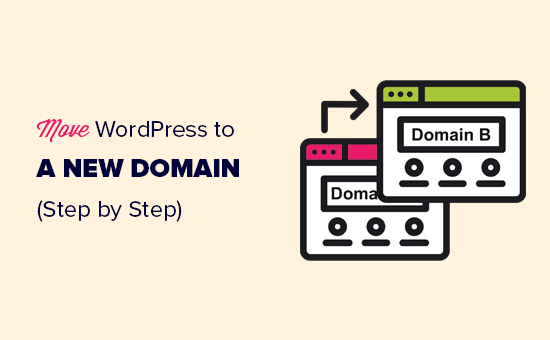
Migrare il tuo sito WordPress su un nuovo nome di dominio può essere spaventoso, ma non deve esserlo. Siamo qui per guidarti in ogni fase del processo.
Puoi fare clic su uno qualsiasi dei collegamenti seguenti per passare a un passaggio specifico della migrazione del tuo sito WordPress su un nuovo nome di dominio:
- Cosa sapere prima di cambiare dominio
- Pre-passaggi: cosa ti serve per iniziare
- Passaggio 1: Crea un pacchetto Duplicator del tuo sito WordPress
- Passaggio 2: Crea un database per il tuo nuovo nome di dominio
- Passaggio 3: Disimballa WordPress sul tuo nuovo nome di dominio
- Passaggio 4: Imposta reindirizzamenti permanenti 301
- Passaggio 5: Notifica a Google il tuo nuovo dominio
- Notifica ai tuoi utenti il nuovo nome di dominio
- Domande frequenti sullo spostamento di un sito WordPress
- Video Tutorial
Cosa sapere prima di cambiare dominio
Prima di iniziare, ci sono alcune cose che dovresti sapere.
Il processo di trasferimento a un nuovo dominio influenzerà *temporaneamente* il tuo posizionamento sui motori di ricerca, poiché Google e altri motori di ricerca dovranno adattarsi ai cambiamenti.
Influirà anche temporaneamente sul tuo traffico di ricerca. Tieni presente che questo è normale e accade a tutti i siti web che passano a un nuovo dominio.
Tuttavia, puoi ridurre drasticamente l'impatto SEO seguendo questa guida. Ti mostreremo il modo giusto per spostare il tuo sito WordPress su un nuovo nome di dominio, impostare i reindirizzamenti 301 corretti e notificare ai motori di ricerca.
Si prega di notare che questa guida non è per spostare un sito WordPress su un nuovo hosting. Questa è solo per cambiare nome di dominio. Sebbene il processo sia simile, ci sono alcuni passaggi aggiuntivi. Questi passaggi aggiuntivi ti aiuteranno a proteggere il tuo posizionamento SEO e il tuo traffico.
Infine, se il tuo vecchio sito web è su WordPress.com, allora devi seguire le istruzioni nella nostra guida su come spostarsi da WordPress.com a WordPress.org invece.
Pre-passaggi: cosa ti serve per iniziare
In questa guida, presumiamo che tu abbia il tuo sito web WordPress configurato su vecchiosito.com e che tu stia cercando di migrarlo su nuovosito.com.
Presumiamo inoltre che tu abbia già un account di hosting WordPress e che tu abbia familiarità con il pannello di controllo del tuo web hosting.
Dovrai anche sapere come usare un client FTP come FileZilla o come modificare i file utilizzando l'app File Manager disponibile nella dashboard del tuo account di hosting.
Nel caso in cui non si disponga di un provider di web hosting o si stia cercando di cambiarne uno nuovo, consigliamo di utilizzare Bluehost (ottimo per piccoli siti + include un dominio gratuito) e SiteGround o WP Engine (ottimo per siti più grandi o negozi online).
Una volta che hai queste cose a posto, sei pronto per iniziare il processo!
Passaggio 1: Crea un pacchetto Duplicator del tuo sito WordPress
La prima cosa che devi fare è creare un backup completo del tuo sito WordPress.
Utilizzerai quindi questo backup per creare una copia duplicata del tuo sito web in modo da poter impostare correttamente i reindirizzamenti dal tuo vecchio dominio a quello nuovo.
Sebbene siano disponibili molti plugin di backup per WordPress, utilizzeremo Duplicator per questo tutorial.
Duplicator è il miglior plugin di backup e migrazione per WordPress. Lo abbiamo utilizzato per migrare innumerevoli siti web per le nostre attività e per i clienti. Lo abbiamo trovato affidabile, anche per siti web molto grandi.
Nota: Esiste anche una versione gratuita di Duplicator disponibile, che puoi utilizzare per questa migrazione. Tuttavia, consigliamo di passare a un piano a pagamento per sbloccare più funzionalità come backup automatici su cloud, ripristino del sito con 1 clic, migrazioni più semplici e altro ancora.
Iniziamo installando e attivando il plugin Duplicator sul tuo vecchio nome di dominio. Per maggiori dettagli, consulta la nostra guida passo passo su come installare un plugin di WordPress.
Una volta attivato, il plugin aggiungerà una voce di menu Duplicator nella tua bacheca di WordPress. Devi andare alla pagina Duplicator » Backups e quindi fare clic sul pulsante 'Crea nuovo' per creare un nuovo backup o una copia del tuo sito WordPress.
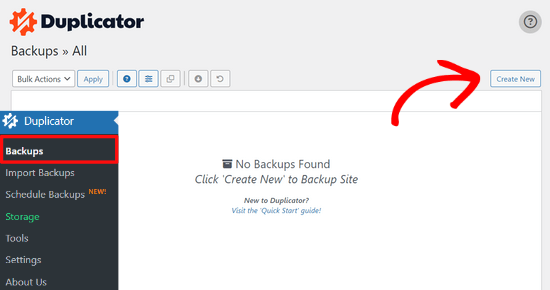
Duplicator inizializzerà ora la procedura guidata di backup e assegnerà automaticamente un nome a questo pacchetto.
Fai clic sul pulsante 'Avanti' per continuare.

Duplicator eseguirà ora alcuni test per verificare se tutto è in ordine. Se il plugin rileva un problema, vedrai un avviso con le istruzioni.
Se tutti gli elementi sono contrassegnati come ‘Buono’, fai clic sul pulsante ‘Crea’.

Il plugin inizierà ora a creare un pacchetto duplicato dei file del tuo sito web. A seconda delle dimensioni del tuo sito, questo processo potrebbe richiedere alcuni minuti.
Una volta terminato, vedrai un'opzione 'Scarica'. Cliccandoci sopra, ti verranno mostrate le opzioni per scaricare Entrambi i file o scaricare separatamente l'Installer e l'Archivio (zip).
Scegli 'Scarica entrambi i file' per scaricarli sul tuo computer.

Il file Archivio è una copia completa dei tuoi file di WordPress. Include i tuoi temi di WordPress, le impostazioni dei permalink, i plugin, i caricamenti e qualsiasi altro file creato dai plugin di WordPress.
Lo script di installazione è un file PHP che automatizzerà ed eseguirà la migrazione di WordPress decomprimendo il file di archivio.
Passaggio 2: Crea un database per il tuo nuovo nome di dominio
Prima di spostare il tuo sito WordPress sul nuovo dominio, avrai bisogno di un nuovo database SQL per decomprimere WordPress sul tuo nuovo nome di dominio.
Se hai già creato un database, puoi saltare questo passaggio.
Per creare un database, devi visitare la dashboard del tuo account di hosting, scorrere fino alla sezione 'Database' e quindi fare clic sull'icona 'Database MySQL'.
Ti mostreremo come individuarlo su Bluehost, ma le istruzioni di base sono le stesse e dovrebbero applicarsi a tutti i provider di hosting.
Accedi alla dashboard del tuo account Bluehost e fai clic sul pulsante 'Impostazioni' sotto il tuo sito web.
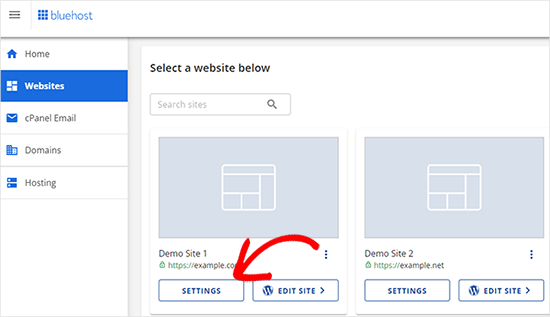
Sotto le impostazioni del tuo sito, devi passare alla scheda 'Avanzate'.
Scorri un po' verso il basso fino alla sezione cPanel e fai clic su 'Gestisci'.
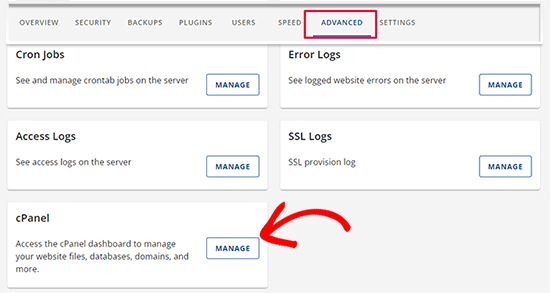
Questo aprirà la dashboard di cPanel.
Scorri verso il basso fino alla sezione Database e fai clic sull'opzione 'Database MySQL'.
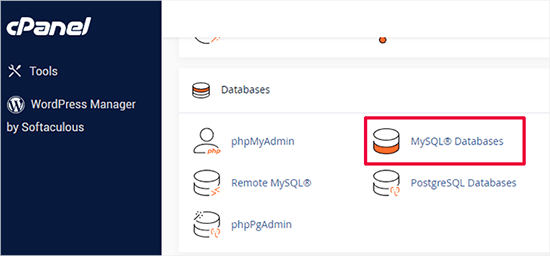
Nota: Il tuo pannello di controllo di hosting potrebbe apparire leggermente diverso dagli screenshot. Tuttavia, dovresti comunque essere in grado di trovare una sezione Database con un'opzione per creare un nuovo database.
Fornisci semplicemente un nome per il tuo database e quindi fai clic sul pulsante ‘Crea Database’.
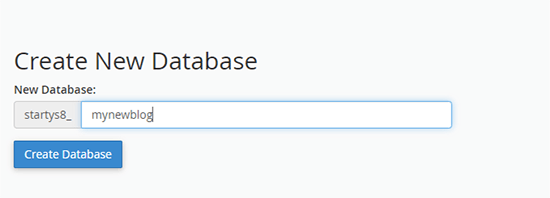
cPanel creerà ora un nuovo database per te. Dopodiché, devi scorrere verso il basso fino alla sezione Utenti MySQL.
Successivamente, fornisci un nome utente e una password per il tuo nuovo utente e fai clic sul pulsante ‘Crea Utente’. Assicurati di annotare il nome utente e la password in un luogo sicuro.
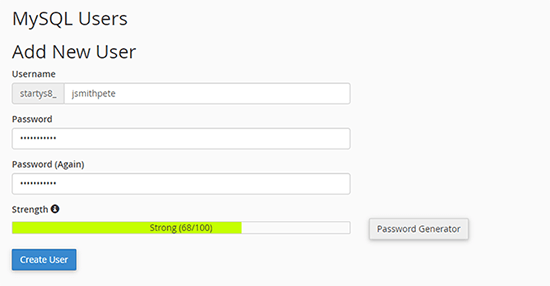
Il nuovo utente che hai appena creato non ha ancora il permesso di lavorare sul database. Cambiamo questo.
Scorri verso il basso fino alla sezione ‘Aggiungi Utente al Database’. Per prima cosa, seleziona l'utente del database che hai creato dal menu a discesa accanto al campo ‘Utente’. Quindi seleziona il nuovo database che hai appena creato e fai clic sul pulsante ‘Aggiungi’.
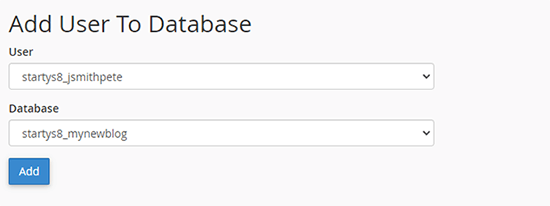
Successivamente, ti verrà chiesto di scegliere i privilegi per l'utente.
Seleziona ‘Tutti i privilegi’ e fai clic sul pulsante ‘Apporta modifiche’ per continuare.
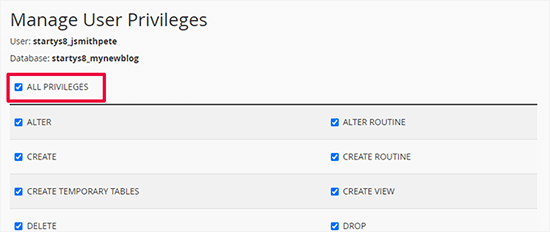
Il tuo database è ora pronto e può essere utilizzato per spostare WordPress al nuovo nome di dominio.
Assicurati di annotare il nome del database, il nome utente e la password. Avrai bisogno di queste informazioni nel passaggio successivo.
Passaggio 3: Disimballa WordPress sul tuo nuovo nome di dominio
Ora devi caricare i file di Duplicator che hai scaricato in precedenza sul tuo nuovo nome di dominio.
Il pacchetto Duplicator include anche la tua installazione di WordPress. Ciò significa che non è necessario installare WordPress sul tuo nuovo dominio.
Innanzitutto, connettiti al tuo nome di dominio utilizzando un client FTP. Una volta connesso, assicurati che la directory principale del tuo sito web sia completamente vuota.
Dopodiché, puoi caricare i file dell'archivio e dell'installer nella directory principale. Questa è solitamente chiamata public_html.
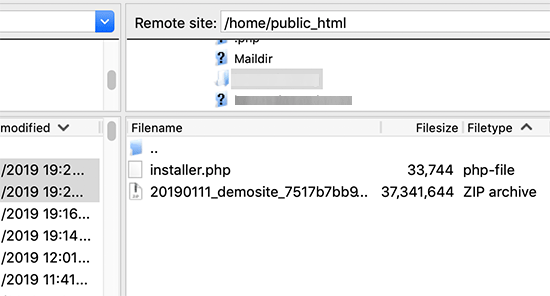
Una volta che entrambi i file sono stati caricati, sei pronto per decomprimere WordPress.
Apri una nuova scheda del browser e vai al seguente URL:
http://example.com/installer.php
Non dimenticare di sostituire example.com con il tuo nuovo nome di dominio. Questo avvierà la procedura guidata di migrazione di Duplicator.
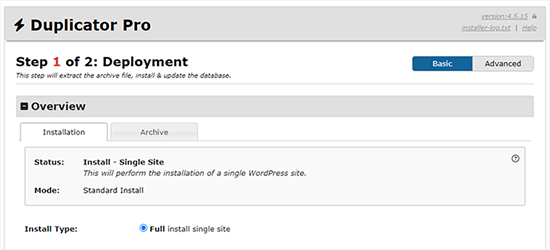
L'installer cercherà il file di archivio e quindi selezionerà automaticamente le opzioni per te sullo schermo.
Scorri un po' verso il basso per inserire le informazioni per il database che hai creato nel passaggio precedente.
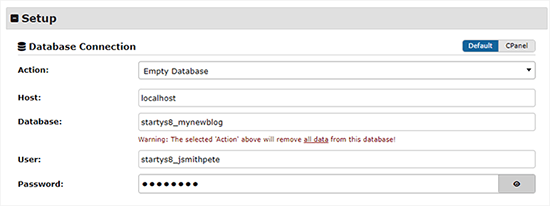
Sotto questo, Duplicator mostrerà automaticamente l'URL del tuo vecchio dominio e del tuo nuovo dominio.
Se tutto sembra a posto, fai clic sul pulsante ‘Valida’ per continuare.
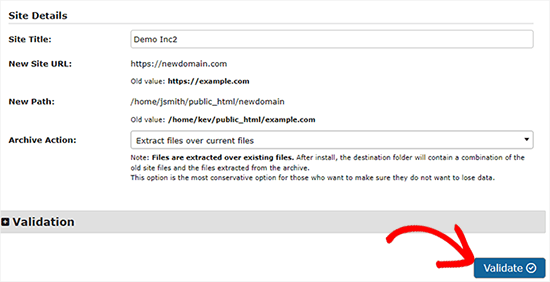
Duplicator tenterà ora di connettersi al database utilizzando le informazioni che hai fornito.
In caso di successo, mostrerà un Passaggio di validazione. Altrimenti, mostrerà un avviso con i dettagli su come risolverlo.
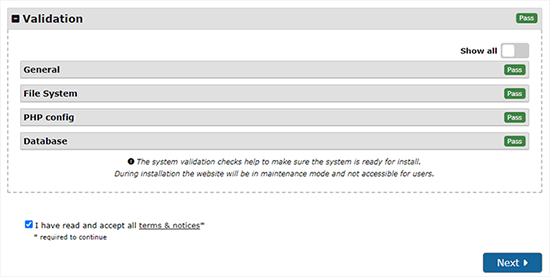
Fai clic sul pulsante 'Avanti' per continuare.
Duplicator inizierà ora a importare il tuo sito web WordPress. Una volta terminato, vedrai un messaggio di successo con un pulsante di accesso all'amministratore.
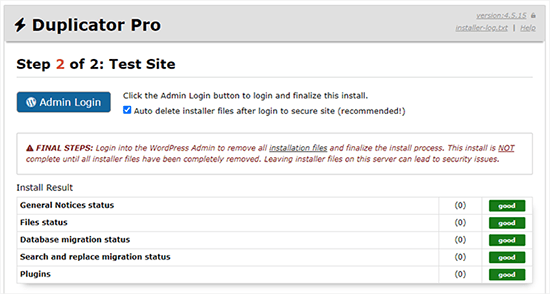
Duplicator aggiornerà automaticamente gli URL al tuo nuovo nome di dominio. Ora puoi fare clic sul pulsante ‘Accesso Admin’ per completare i passaggi successivi.
Passaggio 4: Imposta reindirizzamenti permanenti 301
Il passaggio successivo consiste nell'indirizzare gli utenti che arrivano sul tuo vecchio nome di dominio al nuovo dominio. Questo viene fatto impostando reindirizzamenti 301.
I reindirizzamenti 301 sono molto importanti per la SEO e l'esperienza utente. Aggiungerli ti permetterà di reindirizzare automaticamente utenti e motori di ricerca al tuo nuovo nome di dominio.
In altre parole, ogni volta che qualcuno accede a un post o a una pagina sul tuo vecchio dominio, verrà automaticamente reindirizzato allo stesso post o pagina sul tuo nuovo dominio invece di visualizzare un errore 404.
Per mantenere i tuoi reindirizzamenti, dovrai mantenere attiva la tua vecchia installazione di WordPress in modo che possa continuare a reindirizzare al nuovo sito che hai appena creato.
Ci sono due modi per impostare i reindirizzamenti. Il primo metodo è semplice e richiede solo pochi clic. Il secondo metodo richiede la modifica manuale dei file.
Metodo 1: Imposta reindirizzamenti 301 con All in One SEO
Per questo metodo, avrai bisogno di All in One SEO (AIOSEO). È il miglior plugin SEO per WordPress sul mercato e ti consente di ottimizzare facilmente il tuo sito WordPress per la SEO.
Innanzitutto, devi installare e attivare il plugin All in One SEO sul tuo vecchio dominio. Per maggiori dettagli, consulta la nostra guida passo passo su come installare un plugin WordPress.
Nota: Avrai bisogno almeno della versione Pro del plugin per accedere all'addon del gestore di reindirizzamenti. Puoi anche configurare AIOSEO sul tuo nuovo sito WordPress per aumentare ulteriormente il tuo posizionamento sui motori di ricerca e il traffico.
Dopo l'attivazione sul tuo vecchio dominio, devi visitare la pagina All in One SEO » Redirects e fare clic sul pulsante 'Activate Redirects'.
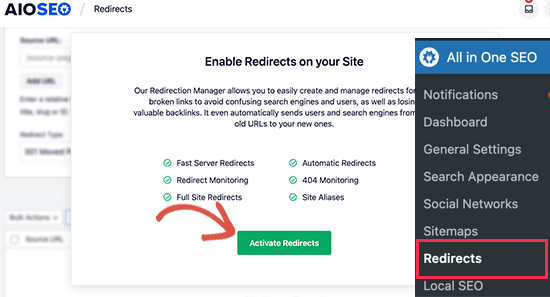
Successivamente, devi passare alla scheda 'Full Site Redirect' e attivare l'interruttore 'Relocate Site'.
Dopodiché, devi inserire il nome del tuo nuovo dominio accanto all'opzione 'Relocate to domain'.
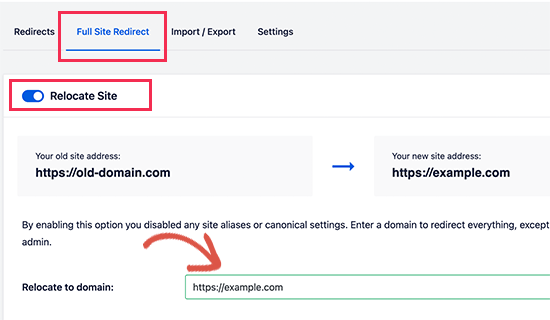
Non dimenticare di fare clic sul pulsante 'Salva Modifiche' per memorizzare le tue impostazioni.
Metodo 2: Imposta manualmente i reindirizzamenti al nuovo dominio
Questo metodo richiede la modifica del file .htaccess di WordPress sul tuo vecchio nome di dominio.
Innanzitutto, devi connetterti al tuo vecchio sito tramite FTP e modificare il file .htaccess.
Questo si troverà nella stessa directory delle cartelle wp-includes o wp-admin. Apri il file .htaccess e incolla le seguenti righe di codice all'inizio:
#Options +FollowSymLinks
RewriteEngine on
Unchanged: RewriteRule ^(.*)$ http://www.newsite.com/$1 [R=301,L]
Assicurati di sostituire newsite.com con il tuo nuovo dominio nel codice sopra.
Una volta applicate queste modifiche, visita il tuo vecchio nome di dominio. Dovrebbe reindirizzarti automaticamente al nuovo dominio.
In caso contrario, significa che il reindirizzamento non è impostato correttamente e il tuo server probabilmente non supporta le regole di reindirizzamento. Devi contattare il team di supporto della tua società di web hosting per attivare RewriteEngine.
Passaggio 5: Notifica a Google il tuo nuovo dominio
Ora che hai spostato WordPress su un nuovo nome di dominio e impostato i reindirizzamenti, è ora di notificare a Google il tuo cambio di indirizzo. Questo aiuterà Google a trovare rapidamente il tuo nuovo dominio del sito web e a mostrarlo nei risultati di ricerca.
Innanzitutto, devi assicurarti che sia il tuo nuovo dominio che quello vecchio siano aggiunti a Google Search Console come due proprietà diverse. Vedi il passaggio 1 nella nostra guida a Google Search Console per le istruzioni.
Successivamente, devi selezionare il vecchio nome di dominio come proprietà attiva nella dashboard del tuo account Google Search Console.
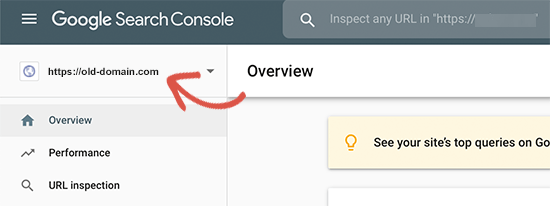
Dopodiché, fai clic sul menu Impostazioni nella colonna di sinistra.
Ora puoi fare clic sullo strumento 'Cambio di indirizzo'.
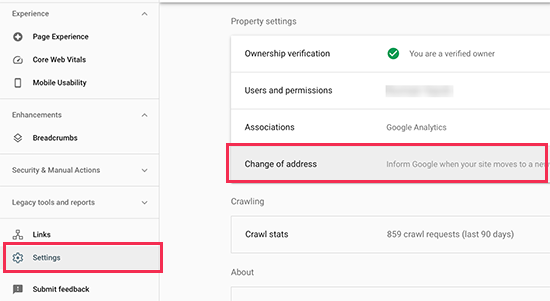
Ora devi selezionare il tuo nuovo dominio dalla sezione Aggiorna Google.
Quindi, dovresti fare clic sul pulsante 'Valida e aggiorna'.
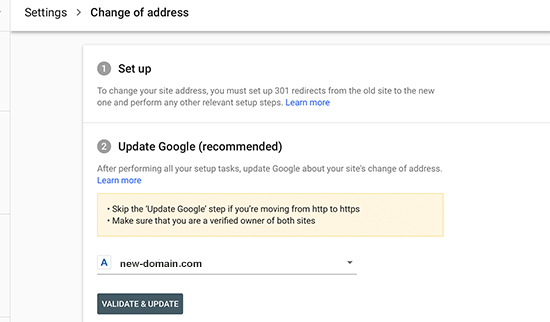
Tutto qui. Google ora verificherà che il tuo vecchio dominio stia reindirizzando al nuovo dominio e salverà le tue modifiche.
Nella schermata successiva, Google Search Console ti mostrerà una procedura guidata passo passo per inviare la tua richiesta di cambio indirizzo.
Notifica ai tuoi utenti il nuovo nome di dominio
Mentre i reindirizzamenti 301 fanno il loro lavoro, è sempre bene fare un annuncio pubblico sulla migrazione.
Puoi farlo semplicemente scrivendo un post sul blog sul tuo nuovo sito e condividendolo sui tuoi account di social media.
Se hai una newsletter via email o iscritti alle notifiche push, allora dovresti inviare un annuncio anche a loro.
Questo può essere utile in molti modi.
Prima di tutto, è più probabile che i tuoi utenti ricordino il nuovo dominio una volta che ne leggono.
In secondo luogo, puoi chiedere ai tuoi utenti di farti sapere se riscontrano bug. Tu da solo non puoi testare il tuo sito in ogni tipo di browser o ambiente di sistema, quindi è sempre utile avere un nuovo paio di occhi che lo esaminino.
Domande frequenti sullo spostamento di un sito WordPress
Comprendiamo che potresti ancora avere alcune domande sulla migrazione del tuo sito WordPress a un nuovo dominio. Ecco le risposte ad alcune delle più comuni che riceviamo per aiutarti a darti piena fiducia nel processo.
1. Cambiare il nome del mio dominio danneggerà permanentemente la mia SEO?
No, non danneggerà permanentemente la tua SEO se segui i passaggi corretti. Mentre un calo temporaneo nei ranking e nel traffico è normale mentre i motori di ricerca elaborano il cambiamento, questa guida è progettata per minimizzare tale impatto.
Impostando correttamente i reindirizzamenti 301 (Passaggio 4) e notificando Google tramite la Search Console (Passaggio 5), stai dicendo ai motori di ricerca esattamente dove ti sei spostato, permettendo loro di trasferire la tua autorità esistente al nuovo dominio.
2. Devo conservare il mio vecchio dominio dopo essermi spostato sul nuovo?
Sì, devi assolutamente mantenere attivo il tuo vecchio nome di dominio per il prossimo futuro. Il tuo vecchio dominio ospita i reindirizzamenti permanenti 301 che guidano sia gli utenti che i motori di ricerca al tuo nuovo sito. Lasciarlo scadere romperebbe tutti quei link, portando a una perdita di traffico e a un calo significativo dei tuoi ranking SEO.
3. Quanto tempo richiede l'intero processo di migrazione del dominio?
I passaggi tecnici in questa guida, dal backup del tuo sito all'impostazione dei reindirizzamenti, possono essere generalmente completati in poche ore. Tuttavia, ci vorrà più tempo affinché i motori di ricerca come Google scansionino e indicizzino completamente il tuo nuovo dominio. Sebbene la notifica a Google acceleri questo processo, potrebbero essere necessarie diverse settimane affinché i tuoi ranking si stabilizzino completamente dopo la migrazione.
4. Posso spostare il mio sito WordPress senza usare un plugin come Duplicator?
Sebbene sia tecnicamente possibile spostare un sito manualmente trasferendo i file tramite FTP ed esportando/importando il database, lo sconsigliamo vivamente alla maggior parte degli utenti.
Una migrazione manuale è complessa e presenta un rischio molto più elevato di errori, come aggiornamenti di URL mancanti o problemi di connessione al database. Un plugin come Duplicator automatizza questi passaggi critici, rendendo il processo più sicuro, veloce e affidabile.
5. Qual è la differenza principale tra spostarsi su un nuovo dominio e su un nuovo host?
Pensala in questo modo: spostarsi su un nuovo dominio è come cambiare l'indirizzo stradale della tua attività. Spostarsi su un nuovo host è come cambiare la società proprietaria dell'edificio, ma il tuo indirizzo rimane lo stesso. Questa guida è specificamente per cambiare il tuo indirizzo (dominio), che ha requisiti SEO unici, come i reindirizzamenti 301, che sono fondamentali per il successo.
Tutorial video
Risorse bonus
I seguenti articoli e tutorial ti aiuteranno a monitorare e recuperare i tuoi ranking SEO dopo la migrazione a un nuovo nome di dominio:
- La checklist definitiva per la migrazione SEO di WordPress (per principianti)
- Come verificare se i tuoi post del blog di WordPress si posizionano per le parole chiave giuste
- Come monitorare i visitatori del sito web sul tuo sito WordPress
- Suggerimenti per ottimizzare i tuoi post del blog per la SEO come un professionista (Checklist)
Speriamo che questo tutorial ti abbia aiutato a spostare il tuo sito WordPress su un nuovo nome di dominio. Potresti anche voler consultare la nostra guida su come ottenere un dominio email gratuito o seguire i passaggi nella nostra guida completa alla SEO di WordPress.
Se ti è piaciuto questo articolo, iscriviti al nostro canale YouTube per tutorial video su WordPress. Puoi anche trovarci su Twitter e Facebook.





Maya
Devo conservare tutti i file sul mio vecchio dominio (l'intera installazione di WordPress) o è sufficiente avere solo .htaccess con reindirizzamento 301?
James
Ciao ragazzi,
Il reindirizzamento 301 non reindirizza le pagine, cosa posso fare?
Logan Cale
Ho avuto un problema simile con il reindirizzamento .htaccess che reindirizzava solo il dominio (pagina principale), ma non le sottopagine, ma quando ho aggiunto anche la riga seguente nel file .htaccess, tutte le sottopagine sono state reindirizzate se avevano lo stesso nome esatto.
Redirect 301 / https://newdomain.com/Euan
Ciao Logan. Tu, amico mio, sei una leggenda. Diverse ore di ricerca perché avevo lo stesso problema: la pagina principale veniva reindirizzata ma nient'altro. Ho aggiunto questa riga di codice e ora è risolto. Grazie!
Kim Saxton
Ciao,
Questo è stato davvero utile, grazie mille, ma ora sono un po' bloccato.
Sono arrivato al passaggio 2 e ho premuto il pulsante di distribuzione sul sito php dell'installer. Poi sono andato via per una settimana, ho apportato alcune modifiche di formattazione al mio nuovo sito (solo colore, logo, nessuna modifica alle pagine).
Ora voglio aggiornare i miei URL nella pagina di aggiornamento dell'installer. Ma non riesco più ad accedervi. Viene visualizzata una pagina di errore 404, pagina non trovata. Vedi
Il mio vecchio sito è
Puoi consigliarmi?
Grazie
Kim
Sorin Vizireanu
Ottimo post, grazie.
Ashley
Ho una domanda. Siamo un'azienda e abbiamo appena costruito un negozio e-commerce sul nostro normale sito web aziendale.
Ora vorremmo prendere solo il negozio e metterlo su un dominio separato.
Come funzionerebbe quel processo?
Supporto WPBeginner
Ciao Ashley,
Dovrai impostare i reindirizzamenti in modo che solo i tuoi URL del negozio vengano reindirizzati al nuovo nome di dominio.
Amministratore
Peter Ishola
Come scarico i file del pacchetto? Devo scaricarli dal mio admin di WordPress o dal mio cpanel perché non trovo alcun link di download nella mia admin di WordPress.
Grazie
Manpreet Singh Rehsi
Ciao,
Grazie per un articolo così dettagliato. Questo mi ha davvero aiutato a spostare uno dei miei blog su un nuovo dominio il mese scorso.
Attualmente il mio blog è in fase di migrazione su Google Webmaster. Ora voglio implementare SSL sul mio nuovo dominio.
Dovrei procedere con l'implementazione di HTTPS o aspettare che la migrazione sia completata su Google Webmaster.
L'SEO subirà un impatto negativo se implemento HTTPS ora.
Ahmed Rifshaan
Salve,
Riguardo al reindirizzamento 301 che hai menzionato, dovremmo modificare il vecchio file .htaccess...
E se non cambiassimo host, ma solo il nome del dominio?
Il mio sito non si sposta, cambia solo il dominio.
In quel caso cosa dovrei fare?
Jay Soriano
C'è una parte che potrebbe essere chiarita un po', e ho letto la maggior parte dei commenti senza trovare una risposta. Per quanto riguarda il reindirizzamento 301, nel post menzioni:
"In altre parole, ogni volta che qualcuno atterra su uno dei tuoi vecchi post o pagine, verrà automaticamente reindirizzato al tuo nuovo sito."
Se atterrano su un vecchio post (vecchiodominio.com/post), verranno reindirizzati al post sul nuovo dominio (nuovodominio.com/post), o semplicemente al dominio principale (nuovodominio.com)?
Supporto WPBeginner
Verranno reindirizzati al post.
Amministratore
Claudio
Per quanto tempo è sicuro continuare a mantenere il vecchio dominio e sito web, dopo aver reindirizzato al nuovo?
Jo
Ciao, non so se puoi aiutarmi. Ho acquistato un nuovo nome di dominio dal mio host. Ho seguito le istruzioni di questo articolo. Quando ho effettuato l'accesso al mio client FTP, l'ho fatto prima sotto il mio vecchio nome di dominio (pensavo fosse necessario) e poi nella scheda 'nuova sessione' ho effettuato l'accesso sotto il mio nuovo nome di dominio. Sotto il mio nuovo dominio sembravano esserci tutti gli stessi file del mio vecchio dominio.
L'articolo diceva di assicurarsi che il file root fosse vuoto, quindi ho cancellato tutti i file dal nuovo nome di dominio nel client FTP e ho caricato il file installer.php e il file zip dell'archivio.
Quando provo ad avviare il file installer.php nel mio browser web, compare un errore 404 e ora sono bloccato. Hai qualche consiglio?
Grazie!
Jo
AGGIORNAMENTO: Sono finalmente riuscito ad accedere al Duplicator e ho aggiunto un nuovo database MySQL ed eseguito i test. Tuttavia, ora quando provo ad accedere per aggiornare i permalink usando lo stesso nome utente e password, dice che non riconosce i miei dati. Ho provato 'password dimenticata' ma non ha riconosciuto la mia email.
Sta anche segnalando un errore HTTP 500 sui miei nuovi (e vecchi) nomi di dominio.
Qualsiasi consiglio sarebbe molto apprezzato, per favore.
Grazie!
Amirhossein
Ciao
Ho un tema installato e attivo sul mio sito wp in questo momento:
1. Ha un tipo di post personalizzato chiamato "video_type".
2. Il pattern dell'URL di tutti i post di tipo "video_type" è questo: mysite.com/video_type/nome-del-video-url. Significa che /video_type/ è sempre presente in tutti gli URL dei post video.
3. Esiste un altro tipo di post personalizzato chiamato "genre". Che funge da "categorie" ma solo per i post di tipo "video_type".
4. Il pattern dell'URL per "genres" è questo: mysite.com/genre/nome-del-genere-url. Significa che /genre/ è sempre presente in tutti gli URL dei generi. E contengono elenchi di post video.
5. Tutti i miei video e generi sono indicizzati su Google e si posizionano molto bene. Alcuni di essi si posizionano tra il 1° e il 3° posto.
Ora voglio cambiare il tema. Il nuovo tema non riconosce “video_type” e “genre”. E non voglio che il tema venga riconosciuto.
Ho deciso di cambiare il "video_type" in "post" con il plugin "Post Type Switcher". Ma dopo aver cambiato tipo:
1. "genre" non è più disponibile per i post (sono disponibili solo le categorie).
2. E non posso cambiare il tipo di post "genre" in "categorie" con quel plugin.
3. mysite.com/genre/the-genre-name-url i generi diventeranno pagine senza contenuto.
4. L'URL dei post video cambia. (non ci sarà più "video_type" nell'URL e non lo voglio MA SEO?)
Ecco i miei obiettivi:
1. cambiare "genre" in "categories".
2. cambiare gli URL di "genre".
3. cambiare "video_type" in "post".
4. cambiare gli URL di "video_type".
5. Voglio anche potare e ottimizzare le mie categorie attuali. (Rimuovere, aggiungere e modificare alcune di esse).
Quindi voglio sapere qual è la best practice qui per "non avere alcun SEO negativo"? E come raggiungere comunque questi obiettivi?
Supporto WPBeginner
Dovrai impostare dei reindirizzamenti. Puoi usare le espressioni regolari (Regex) per rilevare i pattern degli URL e reindirizzarli di conseguenza. Ti preghiamo di consultare la nostra guida su come impostare i reindirizzamenti in WordPress
Amministratore
Michel Fortin
Se ho due siti web diversi e vogliamo trasferirne uno sull'altro. La cosa è che vogliamo chiudere il primo sito ora ma trasferire il contenuto in seguito, quale sarebbe la best practice sul lato reindirizzamento?
Michael Barth
Grazie per quell'articolo, ma il mio problema è un po' più complesso. Ho un reindirizzamento 301 per un nome di dominio che uso per un hoster di siti web con template. Ora ho un nuovo hoster e un sito Wordpress lì. Cambierò il mio 301 per reindirizzare ora al mio nuovo sito Wordpress. Non ho accesso al file htaccess sull'hoster "vecchio", e comunque devo annullare il contratto.
Qualche idea su come fare al meglio?
Grazie.
Sujeet Thakur
Grazie mille di cuore. Tutti i miei problemi sono risolti leggendo il tuo blog. Grazie ancora ..!
saeed
Sto cercando di migrare in sicurezza un sito Wordpress a un nuovo sito HTML senza perdere il ranking di Google. Per favore, contattami.
Sant
Ciao SAEED,
Hai spostato il tuo dominio Wordpress in HTML?
Sto pianificando di spostare il mio sito web da Wordpress a HTML, vorrei sapere se questo influisce sull'SEO?
Potresti darmi qualche suggerimento?
Grazie in anticipo!
Alessandro Bertelli
Ciao.
Sto spostando un sito da un sottodominio fittizio/di prova al dominio definitivo (qualcosa come spostare da temporary.example.com a example.com.)
Mentre tenevo il sito per lo più offline durante lo sviluppo, ho dimenticato per un breve periodo il sito aperto.
Questo è stato sufficiente per far entrare il googlebot e ho trovato molte pagine già indicizzate, con gli indirizzi che iniziano con temporary.example.com/qualcosa invece di example.com/qualcosa.
Ora metterò online il sito all'indirizzo reale e temo che il fatto che le stesse pagine siano indicizzate due volte danneggerà l'SEO.
Non ho traffico precedente o punteggio SEO da salvare dal sottodominio di prova, posso semplicemente eliminare il vecchio sito?
Supporto WPBeginner
Ciao Alessandro,
Una volta che il tuo sito sarà online, potrai impostare un reindirizzamento 301 dall'URL temporaneo al tuo URL attuale. Dai un'occhiata alla nostra guida su home impostare i reindirizzamenti in WordPress.
Amministratore
Alessandro Bertelli
Ciao, grazie per la risposta.
Come ho detto, il sito che voglio spostare non ha SEO da salvare… sono solo preoccupato che Google lo valuti meno a causa delle pagine duplicate (temporanee e non più esistenti).
Il reindirizzamento sarebbe solo per i bot di ricerca.
Un reindirizzamento 301 è una soluzione migliore invece di rimuovere semplicemente il sito?
Supporto WPBeginner
Anche se rimuovi il sito, dovresti comunque dire ai motori di ricerca dove è andato. In questo modo i motori di ricerca non penalizzeranno il nuovo sito attivo per contenuti duplicati. 301 è il codice HTTP che dice ai motori di ricerca che il contenuto che stanno cercando di accedere si è spostato in questa nuova posizione.
Jeffrey Collins
Ho semplicemente reso sicuro il mio sito, cambiando l'URL. Ho usato un reindirizzamento 301 dalla root, questo reindirizzerà tutte le pagine? Questo è un sito WordPress.
Ataul Ghani
ho appena spostato il vecchio dominio sul nuovo dominio. Il processo è stato qualcosa del genere, ho semplicemente installato wp sul nuovo dominio e importato tutti i file e il database. Poi il vecchio dominio ha effettuato un reindirizzamento permanente verso il nuovo dominio. Ho condiviso la sitemap con webmaster e altri motori di ricerca. Inoltre, nell'amministratore di webmaster del vecchio dominio ho detto di cambiare il nome del dominio utilizzando gli strumenti di cambio nome dominio in webmaster. Ma non ho ancora rimosso alcun file dalla directory del vecchio dominio, quindi sarà un problema per me??? Per favore, fatemi sapere.
Grazie!
Rabin Mahmud
Ciao,
Ho un vecchio sito ma voglio reindirizzarlo al nuovo dominio senza perdere alcun SEO juice permanente. Ma ho bisogno di sapere se devo reindirizzare tutti gli URL del vecchio dominio a URL simili del nuovo sito o se devo solo reindirizzare il nome del dominio.
È molto importante per me saperlo.
Grazie
Ravi
Ho reindirizzato correttamente il mio sito al nuovo dominio con un 301. Devo aggiungere la sitemap del nuovo dominio dopo il reindirizzamento e il cambio di indirizzo in webmaster tools? Inoltre, il traffico del mio sito è diminuito significativamente. Circa il 70% di calo in 10 giorni. È normale? E quanto tempo ci vorrà per risalire.
Per favore, rispondi e aiuta.
Sandy Gogoriya
Voglio farti una domanda. Ho due siti web. Uno è vecchio e uno è nuovo. quindi voglio trasferire 5 post del mio vecchio sito web sul mio nuovo sito web. Come sul mio vecchio sito web ho 5 post di smartphone e voglio pubblicare questi post sul mio nuovo dominio con il contenuto del vecchio sito web che è già stato pubblicato, quindi cosa faccio ora.
Ernest
Ciao, grazie per l'ottima spiegazione! Mi stavo chiedendo, mettere il codice nel file htacces significa che non ho bisogno di reindirizzare tutti i singoli link? Stavo guardando il plugin 301 simple redirects, ma lì devo inserire ogni singolo link.
Il mio vecchio sito è online da un po' di tempo, quindi vorrei mantenere i valori delle pagine per Google.
Cordiali saluti!
Josh
Cosa si dovrebbe fare con il contenuto del sito originale dopo che il contenuto duplicato, tutti i reindirizzamenti 301 e il cambio di indirizzo nella search console sono completi? È meglio rimuovere il contenuto originale? C'è la possibilità che venga penalizzato come contenuto duplicato?
Supporto WPBeginner
Non è necessario che il contenuto sia attivo per impostare un reindirizzamento da un'installazione WordPress a un'altra. Ma se lo è, allora va bene lo stesso, perché i tuoi utenti e i motori di ricerca non rimarranno sul vecchio contenuto e verranno reindirizzati. Se il tuo contenuto fosse ospitato su una piattaforma come WordPress.com o Blogger, allora ti raccomanderemmo di mantenere il tuo contenuto in modalità privata per almeno sei mesi.
Amministratore
David Budimir
Ciao,
Stiamo migrando il nostro blog da blog.dominio.com a dominio.com/blog. Il nostro sito è attualmente attivo sul nostro dominio principale, migrare il blog nello stesso database significa che dobbiamo accedervi in modo diverso?
In altre parole, influenzerà il nostro processo di creazione di contenuti per il blog nella dashboard di WordPress?
Grazie!
Supporto WPBeginner
No, non influirebbe sulla creazione del blog. Tuttavia, potrebbe essere necessario aggiornare gli URL nel database per assicurarsi che puntino alla nuova posizione.
Amministratore
sudhir
Grazie team WPBEGINNER per aver scritto un articolo così fantastico e utile. Ho seguito attentamente tutti i passaggi e ho migrato il mio vecchio dominio al nuovo dominio, tutto funziona bene tranne una cosa: il mio vecchio URL di casa non reindirizza al nuovo, mentre tutte le pagine interne vengono reindirizzate alle nuove pagine.
Michall Helmbæk
Grazie per il miglior articolo da molto tempo che funziona davvero!
suhan ahmed
Voglio spostare il mio sito abilitato per HTTPS su un nuovo dominio abilitato per HTTPS per scopi di rebranding. Ad esempio,
Da https olddomain.com
A https newdomain.com
Per inserire il codice 301 nel file .htaccess del vecchio dominio. Devo mantenere intatta l'installazione del vecchio dominio.
Il problema è che avrei bisogno di due SSL, IP (in alcuni casi, server) che è un po' costoso per me.
Quale potrebbe essere la soluzione migliore qui?
O
Posso seguire il metodo menzionato di seguito!!!
Se torno al mio https olddomain A http olddomain
E poi da olddomain A newdomain.
Perderò il ranking o sarò penalizzato da Google qui?
roshan christy
Ciao.,
Questo articolo è esattamente quello che cercavo oggi, ma ora sono un po' confuso. Il mio blog è stato hackerato e infettato da un malware di reindirizzamento condizionale. Poiché il mio provider di hosting consente due installazioni gestite di WordPress, ho migrato la cartella 'uploads' e il database all'altra. Ora desidero cambiare anche il nome del dominio, poiché quello attuale ha molti siti web di spam esterni indicizzati da Google come sottodomini. Voglio mantenere il vecchio nome di dominio ma eliminare il vecchio sito con i malware. Ma questo articolo suggerisce di mantenere il vecchio sito web con la modifica di .htaccess. Posso usare il vecchio dominio insieme al nuovo eliminando il vecchio sito web?
Leonardo
Bello, grazie. È stato molto utile!
New
Ciao
Se sposto semplicemente i miei contenuti di WordPress su un nuovo sito con lo stesso dominio che sto utilizzando, è necessario eseguire un reindirizzamento 301?
Rocky
Nei nuovi Strumenti per webmaster di Google non c'è alcuna opzione per la modifica dell'indirizzo. per favore, dimmi ora come posso notificare a Google.
Joey Espinoza
Ottimo tutorial, grazie
Aron Jay
Funziona per post specifici o reindirizzerà automaticamente tutto al nuovo dominio?
Ho intenzione di spostare alcuni dei miei post su un altro dominio, non l'intero blog. Grazie!
Michael J.
Ciao WPBeginner – La tua guida passo passo è ottima… ma ho solo una rapida domanda per confermare prima di procedere con la modifica del mio dominio WordPress…
Sfortunatamente, il plugin Duplicator non funziona per me… quindi, posso copiare e incollare manualmente un backup del mio sito 'vecchio' in una nuova directory per il 'nuovo dominio?… e seguire il resto dei passaggi sopra.
Inoltre, sto usando lo stesso hosting per il mio dominio vecchio e nuovo — Quindi, devo creare una nuova cartella di directory per il 'nuovo' dominio — e mantenere la cartella del dominio 'vecchio' sul mio hosting?… in pratica, il mio hosting avrebbe (2) cartelle del sito?… quella vecchia e quella nuova.
Ho letto in vari posti che devo solo puntare al nuovo dominio su WordPress… tuttavia, sono estremamente preoccupato di perdere i miei ranking SEO dal vecchio dominio, quindi sono stato un po' esitante con il processo..
Qualsiasi risposta sarebbe molto apprezzata… Grazie!
Supporto WPBeginner
Dovresti creare una nuova directory sul tuo server di hosting. Scarica tutti i tuoi file WordPress e poi caricali nella nuova directory. Dovrai anche esportare il tuo vecchio database. Crea un nuovo database nel tuo cPanel di hosting. Apri phpmyAdmin e poi importa il tuo vecchio database. Il resto dei passaggi sarà lo stesso.
Amministratore
Michael J.
Grazie per la risposta!… Mi assicurerò di seguire le tue istruzioni dettagliate.
Bunty Pundir
Ciao,
Ho creato il pacchetto con il plugin Duplicator e ho anche caricato il file installer e il pacchetto archive sul nuovo dominio, ma non riesco ad avviare installer.php usando example.com/installer.php e il browser mostra server non trovato!
Aiuto per favore:-(
Mihira
Successo!
Avevo paura di trasferire il mio dominio da .in a .com da 6 mesi o più. Questa guida è così facile da seguire, ero operativo sul nuovo dominio entro un'ora. Grazie wpbeginner per questo post utile.
Una domanda però… Il mio vecchio dominio non aveva caratteristiche SEO così eccezionali da trasferire. Non voglio più usare quel vecchio dominio. Posso impostare un reindirizzamento 301 in .htaccess del vecchio sito e lasciarlo SENZA RINNOVARE IL DOMINIO QUANDO SCADE TRA UN PERIODO?
Per favore, fammelo sapere!
Supporto WPBeginner
Sì, puoi farlo. Tuttavia, si raccomanda di mantenere il dominio attivo con i reindirizzamenti per almeno 90 giorni. Dovresti anche inviare una richiesta di cambio indirizzo a Google dagli strumenti per webmaster di Google.
Amministratore
Edward
Un'altra domanda: se elimino tutte le vecchie immagini nella cartella del vecchio sito, google webmaster mi dirà che ci sono 100.000 percorsi morti e dovrò eliminarli uno per uno. Dovrei semplicemente lasciare intatta la cartella delle immagini? Non voglio vedere tutte quelle notifiche di file mancanti nel mio account webmaster.
Edward
Manterrò lo stesso dominio .com ma le immagini nelle vecchie pagine avranno un nome diverso. (ad esempio, da 0429_lg.jpg a ocean_home.lg.jpg, quindi sto cambiando il nome di 10 immagini (ora avranno il doppio di quel numero) su ogni elenco con un nome diverso. Questo influisce sulla SEO? Immagino che avere il nuovo nome SEO-friendly nelle immagini potrebbe essere ancora meglio.
Shreya
Ciao!
Recentemente ho provato a migrare il mio sito web WordPress a un nuovo dominio (server condiviso) ma il plugin Duplicator non ha funzionato. Poi ho optato per la migrazione manuale, tutto funziona bene ma non riesco ad accedere alla mia pagina wp-login.php per il mio nuovo sito sul nuovo dominio.
Puoi per favore aiutarmi in questa questione? Fornirò maggiori dettagli su entrambi i miei siti web.
Grazie.
Zane
Grazie! Ho seguito le istruzioni e ha funzionato perfettamente.
Duane Reeve
Sto migrando il dominio di un cliente e un post relativamente vecchio su MOZ.com afferma che si dovrebbero reindirizzare gli URL individualmente. Sebbene MOZ sia un leader del settore nella SEO, ne dubito poiché il loro post è del 2009. È eccessivo o è il modo migliore per procedere?
Supporto WPBeginner
Se hai un sito statico con meno di 10 pagine, allora ha senso. Ma se stai spostando un sito con centinaia di post, sarà piuttosto difficile impostare manualmente ogni reindirizzamento.
Amministratore
Duane Reeve
Grazie – Il sito WordPress dei clienti aveva 36 pagine/post, che ho reindirizzato manualmente utilizzando il Redirect Plugin. Ho quindi aggiornato la sitemap e l'ho reinviata sia a Google che a Bing.
Non ho reindirizzato gli URL delle immagini o dei tag.
Dopo 48 ore dall'esecuzione dei reindirizzamenti di pagine/post, ho inviato la modifica dell'indirizzo URL sia a Google che a Bing Webmaster Tools. Ho deciso di dare a entrambi i motori di ricerca il tempo di rilevare i reindirizzamenti di pagine/post e farò un reindirizzamento di dominio (usando il file .htaccess) alla fine della settimana.
Sulla base delle mie analisi di Google Analytics e Google Webmaster Tools per il nuovo dominio, sono abbastanza soddisfatto dei risultati finora.
Dario Fumagalli
Quello che dice Moz è sicuro al 100%, mentre quello che dice WPBeginner ha un grosso problema: la sitemap del vecchio sito web.
L'aggiunta di un reindirizzamento 301 a livello di sito, **reindirizza anche** le chiamate alle vecchie sitemap, mentre Google ha bisogno che rimanga lì per dimostrare che sia la vecchia che la nuova sitemap sono uguali o simili.
Pertanto, se lo fai alla maniera di Moz sei ultra-sicuro, se lo fai alla maniera di WPBeginner devi aggiungere eccezioni per escludere tutto il vecchio indice della sitemap (se presente) e le sitemap finché Google non capirà che entrambi si riferiscono alla stessa proprietà.
Mark D
Ciao, non ho un provider FTP. Quando ne ho caricato uno, ha attivato il mio software antivirus. Sto cercando di creare un sito web per un'amica basato sul mio sito. Esiste una soluzione semplice e non FTP per clonare il sito sul dominio della mia amica? Una volta che sarà lì, potrò aggiornarlo con i suoi contenuti.
Grazie,
Lynn Dye
È una buona idea eliminare il mio vecchio sito (eccetto il file .htaccess) sul mio vecchio host in modo da non avere 2 siti identici su due host?
Nelson
Potresti creare un tutorial per spostare un sito WordPress su un nuovo dominio senza plugin, ad esempio spostare una sottocategoria sul sito principale o un sottodominio sul sito principale senza plugin.
Satish
Ciao, articolo molto utile ma ho un dubbio. Cosa succede se scarico il mio backup manualmente creando uno zip, e scarico anche il database da Mysql dal cpanel.
E poi carica manualmente nel file manager del nuovo host. Devo cambiare l'URL nel database da old-domain.com a new-domain.com prima di caricare il database in mysql?
Spero tu capisca cosa sto dicendo!
Daniel Ruyter
Domanda sui reindirizzamenti – Attualmente gestisco due siti (due TLD, due host) e vorrei consolidarli in un unico sito, ritirando l'host del sito "vecchio". Posso reindirizzare il TLD "vecchio" al nuovo a livello DNS e poi aggiungere regole di riscrittura al file .htaccess del mio sito "nuovo" per i post migrati?
Grazie!
-Daniel
Lynn Dye
Questo ha funzionato bene – domanda sul reindirizzamento. Ho cambiato il mio dominio E l'hosting. Quindi vorrei chiudere il mio vecchio account di hosting.
Per quanto tempo dovrei mantenere il reindirizzamento per il mio vecchio dominio? Ho intenzione di mantenere il vecchio dominio per un po' di tempo.
Un inoltro sul vecchio dominio otterrebbe lo stesso risultato del reindirizzamento 301?
Daniel Ruyter
Consiglierei di mantenere il vecchio nome di dominio reindirizzato per tutto il tempo possibile.
Lynn Dye
Se avessi usato BackupBuddy per spostare il mio sito su un nuovo dominio e poi avessi seguito le istruzioni per fare il reindirizzamento 301, non dovrei ottenere lo stesso risultato?
Cosa mi dici di digitare l'URL vecchio e nuovo che Duplicator ti fa fare – come si fa quel passaggio con BackupBuddy?
Grazie per un post interessante.
Supporto WPBeginner
Sì, puoi usare anche BackupBuddy.
Amministratore
Katie Steckly
Quindi, se trasferisco il mio sito con queste istruzioni esatte, Google Analytics continuerà a funzionare automaticamente? O devo reinstallare il codice di tracciamento sul mio nuovo sito e rimuoverlo da quello vecchio?
Travis Pflanz
Google Analytics continuerà a funzionare finché utilizzerai lo stesso codice UA di prima. Detto questo, potrebbe valere la pena impostare una nuova vista nella tua dashboard di Google Analytics dopo aver apportato la modifica.